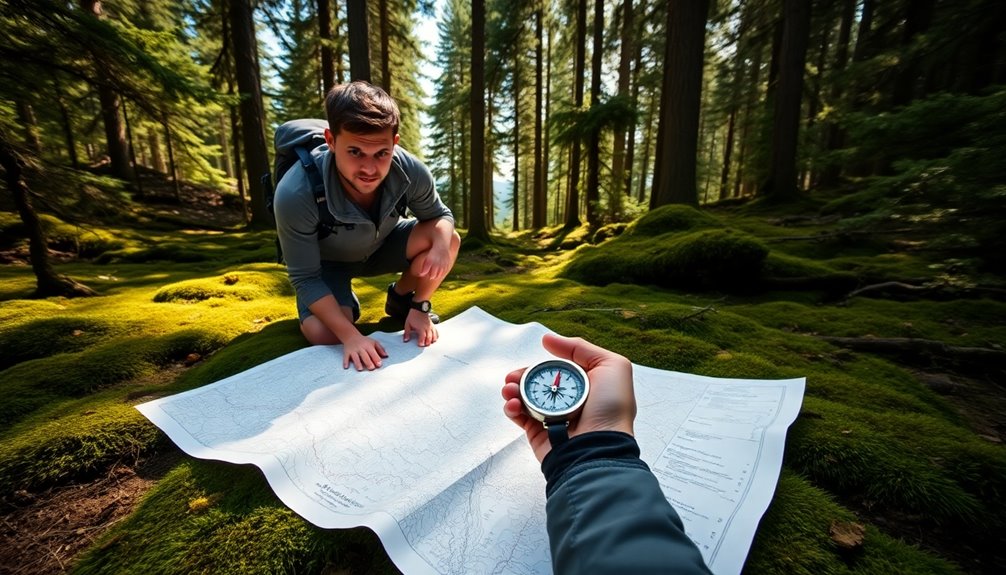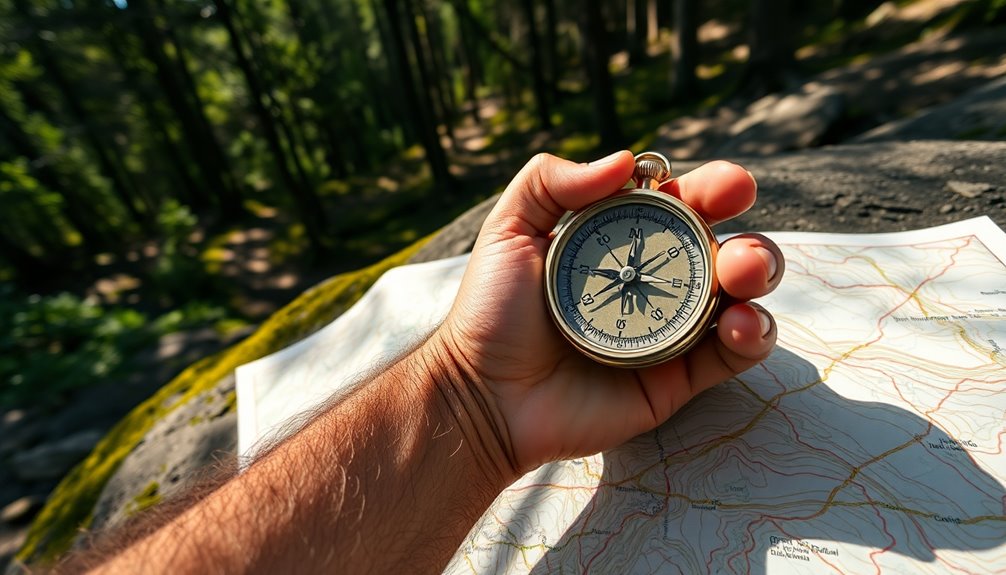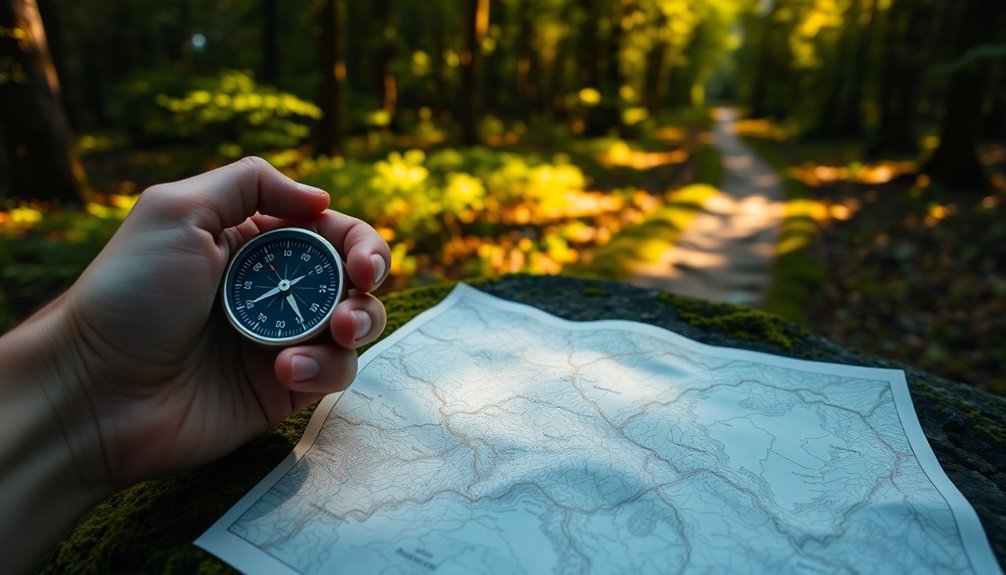Knowing how to read a map and use a compass can save your life in the great outdoors. Start by orienting your map with north, aligning it with the compass. Identify your location using grid references and landmarks. Plot your course by taking accurate bearings, and follow them while keeping your eyes on recognizable features. Always adjust for magnetic variation to stay on track. Regularly maintain your maps and compass, ensuring they're ready for your next adventure. With practice and some added insights, you'll navigate with confidence and ease. Let's explore these essential skills further for your next journey.
Key Takeaways
- Always adjust the compass for magnetic declination to ensure accurate navigation and orientation on your map.
- Familiarize yourself with map symbols and legends to identify features and navigate effectively.
- Use grid references to pinpoint exact locations and understand the map scale for distance estimation.
- Regularly practice taking bearings and drawing lines on maps to create intersecting points for precise location estimation.
- Store maps and compasses properly and review them frequently to maintain navigation skills and preparedness for emergencies.
Importance of Navigation Skills

In today's fast-paced world, mastering navigation skills is more important than ever. Your ability to find your way impacts not just your daily commute but also your safety and efficiency. Studies show that people raised in urban environments often struggle more with navigation than those from rural areas. This difference arises partly because complex, organically designed city layouts enhance cognitive engagement, while grid-like cities can hinder your navigation abilities.
Strong navigation skills rely on various cognitive processes, including memory, mental imagery, and attention to your surroundings. Engaging with complicated environments can actually strengthen the neural systems that support these processes. For instance, if you're involved in fields like geoscience or geography, honing your spatial skills through tools like GIS can set you up for success. Additionally, research indicates that complex environments positively affect navigational skills, further emphasizing the importance of diverse spatial experiences.
Moreover, understanding that navigation skills can improve with practice is essential. Whether you're a student or a professional, actively training your spatial awareness can make a significant difference. Recognizing your unique strengths and weaknesses in navigation can help you develop strategies that work best for you, ultimately enhancing your overall navigational competence.
Orienting Your Map

Orienting your map sets the foundation for effective navigation. To start, you'll need to adjust your compass for magnetic declination, which is the difference between magnetic and true north. Use the declination diagram on your map to set your compass correctly, ensuring the magnetic needle aligns with the magnetic north line on the map. Understanding compass components is crucial for proper navigation.
Once that's done, place your compass on the map with the direction of travel arrow pointing toward the top. Align the edge of the compass with a north-south line on the map while keeping the orienting lines on the compass parallel to the north-south grid lines.
Here's a handy guide:
| Step | Action |
|---|---|
| Adjust for Declination | Align compass with declination diagram |
| Align Compass & Map | Place compass with arrow pointing up |
| Rotate Until Aligned | Turn both until the needle is in the arrow
Plotting Your Course

When plotting your course, start by identifying key locations on your map to set your route. Next, determine your bearing accurately to guarantee you're heading in the right direction. Finally, break your course into waypoints, making navigation easier and more manageable. Additionally, understanding basic terms in map reading will enhance your ability to navigate effectively.
Identify Key Locations
To effectively identify key locations for your journey, start by familiarizing yourself with the map's features and symbols. Understanding these elements is essential for maneuvering accurately and ensuring you reach your destination safely. Pay attention to the following key aspects:
- Map Scale: This indicates the relationship between distances on the map and actual ground distances. Use it to measure distances accurately.
- Grid References: Familiarize yourself with the grid lines (eastings and northings) on the map. These help you pinpoint exact locations using four- or six-figure grid references.
- North Indicators: Identify the north point on your map. Knowing the difference between true north, grid north, and magnetic north can help you maintain orientation.
- Map Legends: Refer to the legend to understand the symbols representing various features. This knowledge allows you to identify roads, buildings, and terrain accurately. Additionally, having a strong grasp of map reading skills significantly enhances your outdoor knowledge and safety.
Determine Bearing Accurately
Determining your bearing accurately is essential for effective navigation and plotting your course. Start by aligning your map and compass. Make sure the map is oriented so the top matches north. Place the compass on the map, ensuring its north-south axis runs parallel to the map edges. Align the compass housing with the grid north on the map, checking that the big red arrow points to the map's north. Adjust for any magnetic variation if necessary.
Next, position the compass for bearing. Connect your starting point (A) and target point (B) using the compass edge, ensuring the direction of travel arrow points toward your target. Keep the compass level and away from metallic objects. If using a round lensatic compass, use imaginary lines or notches for alignment.
Now, adjust the compass housing. Twist it until the orienting lines inside the housing parallel the north-south grid lines on the map, confirming the orienting arrow points toward the map's north. Finally, read and adjust the bearing. Remove the compass from the map, read the bearing at the index line, and adjust for magnetic variation if needed. Your adjusted bearing will guide you toward your target point. Accurate bearings are vital for preventing navigational errors that could lead to unintended detours.
Break Course Into Waypoints
After accurately determining your bearing, the next step is breaking your course into waypoints to guarantee a smooth navigation experience. This process involves dividing your route into manageable segments, making it easier to track your progress and navigate effectively.
- Identify Key Terrain Features: Use topographic maps to pinpoint landmarks, roads, and water bodies. Recognizing contour lines will help you understand elevation changes and terrain layout.
- Break Down the Route: Divide your course into waypoints by identifying critical points like turns and intersections. Assign specific coordinates or descriptions to each waypoint for clarity.
- Create a Navigation Plan: Plan your route in advance, considering any potential obstacles. Pack essential navigation gear and create a checklist for each waypoint; this is essential for ensuring you have the necessary tools for urban and wilderness navigation.
- Track Progress and Adjust: As you move, orient the map to match your direction of travel. Use your compass alongside the map to stay on course, making adjustments as needed based on your encounters with the terrain.
Locating Your Position

Locating your position accurately while steering can make all the difference in your outdoor adventure. Start by using transit lines. Identify two or more features on your map that align with your journey—like walls or fences. Draw a line through these features and extend it across the track you're walking on. When the landscape features line up, the crossing point indicates your location.
If you prefer back bearings, take bearings of three identifiable features in sight, ideally spaced 120º apart. Convert these magnetic bearings to grid bearings considering magnetic variation. Draw lines on the map for each bearing; where they intersect forms a triangle, with its center marking your approximate location. Understanding **compass rose orientation helps ensure you are accurately interpreting your bearings as you navigate.
You can also determine the slope aspect by facing down the slope and taking a reading with your compass. Match this slope aspect with your map to find a corresponding slope. Using multiple slopes can enhance accuracy.
Walking on Your Bearing

Walking on your bearing is vital for staying on course during your outdoor journey. By accurately following your compass bearing, you can navigate confidently through various terrains. Here's how to effectively walk on your bearing:
- Hold the Compass Level: Keep your compass flat and perpendicular to the ground. This guarantees accurate readings.
- Align the Arrows: Rotate your body until the red magnetic arrow points inside the orienting arrow. This alignment is essential for precise navigation.
- Identify Landmarks: Look along the direction of travel arrow to spot a landmark in the distance. This helps you maintain a straight path. Remember to account for magnetic variation when following your bearing to ensure you are on the correct track.
- Keep Sight of the Landmark: As you walk towards the chosen landmark, keep it in sight. If you lose it, stop and take a new bearing to regain your direction.
Navigating With Landmarks

When you're out in nature, identifying key landmarks can make navigation much easier. By using mountains, rivers, and unique rock formations, you can stay oriented and find your way. Let's explore how to effectively use these landmarks for navigation and improve your outdoor skills. Understanding topographic maps can further enhance your navigation skills by providing detailed information about the terrain and elevation changes you may encounter.
Identifying Key Landmarks
Finding your way with landmarks can greatly enhance your ability to orient yourself in the wilderness. By identifying key natural features, you can create a mental map that keeps you on track. Here are some essential landmarks to look for:
- Mountains and Hills: Use the highest peaks as reference points, and follow ridge lines to maintain your general direction. Maps can help you identify these physical features before you set out on your journey.
- Water Bodies: Rivers and streams are predictable and often lead you to lower elevations. Keep an eye out for safe crossing points.
- Rock Formations: Unique shapes and colors stand out in the landscape. Match these formations with your map to confirm your location.
- Vegetation Patterns: Different tree species and tree lines reveal elevation changes. Recognizing these can guide you through various terrains.
Using Landmarks for Navigation
Utilizing landmarks effectively can greatly improve your wayfinding skills in the wilderness. Start by identifying prominent peaks; these distinctive mountains serve as reliable reference points. Understand ridge lines to maintain your general direction, and use contour lines on topographic maps to visualize elevation changes and plan your route. Additionally, recognizing natural landmarks is essential before applying navigation techniques, as they provide dependable reference points in the landscape.
When traveling near rivers and streams, follow the flow. Rivers often lead to lower elevations and can guide you toward populated areas or other trails. Be sure to identify safe crossing points on the map to avoid dangerous areas. The direction of water flow can also help determine your overall direction.
Rock formations and cliffs provide visual cues. Look for distinctive shapes or colors to confirm your location and direction. Match these formations with your map to enhance your accuracy. Similarly, recognize vegetation patterns and tree species, as they often indicate specific elevations or soil types. Tree lines can signal your position on a slope, while seasonal changes in vegetation can offer additional wayfinding clues.
Maintaining Your Map and Compass

A well-maintained map and compass are essential tools for any outdoor enthusiast, ensuring you navigate with confidence. Regular maintenance of these tools is vital to avoid misdirection and enhance safety during your adventures. Here are four key practices to keep in mind:
- Store Properly: Always keep your map and compass in a dry, safe place. Avoid exposing them to extreme temperatures or moisture, which can cause damage.
- Regular Reviews: Check your map at least once a year to confirm its relevance. Updates may be needed to reflect new trails or changes in terrain. Additionally, consider creating high-level maintenance process maps to visualize your navigation strategies and ensure you're prepared for any unexpected changes.
- Stakeholder Involvement: When you share your outdoor plans, involve others. Discuss your routes and maps with friends or guides to gather insights that could enhance your navigation.
- Continuous Learning: Treat your map and compass as living tools. Engage in workshops or local hiking groups to enhance your skills and stay updated on best practices.
Preparing for Emergencies

When you're out in the wilderness, preparing for emergencies can make the difference between a minor inconvenience and a serious situation. Start by familiarizing yourself with map symbols, like blue lines for water and brown contour lines indicating slopes. Knowing these symbols helps you align your map with the terrain, making navigation easier. Additionally, understanding that traditional navigation methods can enhance your situational awareness is crucial.
Next, understand your compass. The red end of the floating arrow always points north. Align the compass bezel with the map's north-south grid lines for accurate orientation. By taking a bearing towards a landmark, you can navigate effectively, adjusting for declination to maintain precision.
Estimating distance and time is essential. Use map grid squares to gauge distances—typically, one square equals one kilometer. Remember, average walking time is around 15 minutes per kilometer on flat ground, so adjust your estimates based on terrain difficulty.
Frequently Asked Questions
How Do I Choose the Right Map for My Area?
To choose the right map for your area, first, consider its primary use—whether you need it for navigation, thematic analysis, or distance measurement. Next, check the scale; larger areas often use smaller scale maps, which may distort details. Think about the geographic features of your region, as specific projections minimize distortion effectively. Finally, verify the map's visual appeal and readability align with your needs, making it easier to interpret the information.
What Should I Do if I Get Lost Despite Using a Compass?
If you get lost despite using a compass, stop moving to avoid confusion. Take a moment to gather your thoughts. Check for visible landmarks or the sun to help with navigation. If you can’t find your way, use alternative methods like observing tree orientations or wind patterns. Make yourself visible for potential rescuers, and consider staying put if you’re hurt. This conserves energy and aids in your chances of being found. If night is approaching, find a safe place to stay and build a fire if possible. Nature’s hidden GPS revealed through natural signs and patterns can provide valuable clues for navigation and survival. Remember to stay calm and focused, and use all available resources to increase your chances of being found.
Can Map Reading Skills Be Learned Through Online Resources?
Did you know that over 60% of people struggle with basic map reading skills? You can definitely learn map reading through online resources. Engaging lessons and interactive tools make it easier for you to grasp essential skills. With self-paced learning and immediate feedback, you'll understand maps in no time. Plus, the real-world applications guarantee that what you learn is practical and relevant, helping you navigate confidently in various situations.
How Often Should I Practice My Navigation Skills?
You should practice your navigation skills regularly to keep your proficiency sharp. Start with short sessions and gradually increase their complexity as you improve. Incorporate varied exercises like the Three-leg Compass Walk and map reading drills into your routine. Aim to navigate in different terrains and weather conditions to adapt to real-world challenges. Set specific goals to track your progress and refine your techniques, ensuring you're always ready for your next outdoor adventure.
What Are Common Mistakes to Avoid When Using a Compass?
When using a compass, avoid common mistakes to guarantee accurate navigation. Don't hold your compass near metal or electronics, as they can skew the needle. Always keep the compass level and check for magnetic variation. Make sure the map is oriented correctly and take back bearings to confirm your path. Measure distances and rely on visual clues, not just the map. Finally, always carry a backup compass in case of equipment failure.
Conclusion
Mastering map and compass skills is like having a GPS in your back pocket, guiding you through the wild. By orienting your map, plotting your course, and using landmarks, you'll navigate confidently. Remember, every step you take can lead to safety, especially in emergencies. So, whether you're hiking in the woods or exploring new terrain, trust your skills. With practice, you'll be ready to tackle any adventure that comes your way, ensuring you never lose your way.










